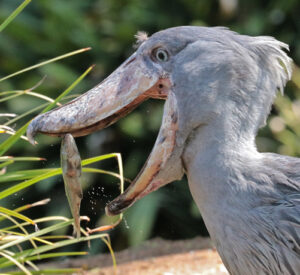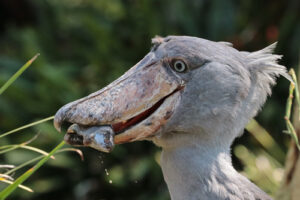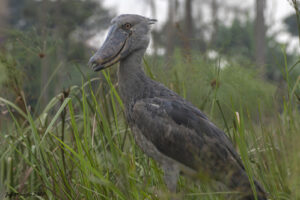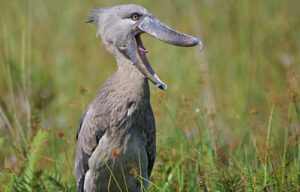The Shoebill Stork is a large long-legged bird with an oversized shoe shaped beak from which it derives its name. The Shoebill Stork has dinosaur-like looks and is also often referred to as a whale-headed  stork. This rare bird is native to Africa and can be found in Botswana, Uganda, Sudan, Congo, Zambia, Kenya and Tanzania. An adult Shoebill Stork has gray feathers, yellow eyes and a white belly while their chicks have bluish -grey feathers with a light colored beak. They prefer living in swampy marshes and other water sources like lakes or rivers.
stork. This rare bird is native to Africa and can be found in Botswana, Uganda, Sudan, Congo, Zambia, Kenya and Tanzania. An adult Shoebill Stork has gray feathers, yellow eyes and a white belly while their chicks have bluish -grey feathers with a light colored beak. They prefer living in swampy marshes and other water sources like lakes or rivers.
The Shoebill Stork was at first considered to belong to the stork family but Researchers later discovered something different. They found that the bird actually belongs to the pelecaniformes and Balaenicipitidae family. Pelicans and herons also belong to this group and thus have a similar genetic composition. Here are other interesting facts about the Shoebill Stork that you might not know: –
Facts About the Shoebill Stork
One of the Largest beaks in the world: The Shoebill Stork has the 3rd longest beak in the world. The title of longest beak belongs to the Toucan. The Shoebill Stork’s beak measures up to 20cm in width and 24cm in length enabling it to hunt both small and large prey.
 An Excellent Hunter: The Shoebill Stork is a very tactful day and night hunter. It will carefully calculate it’s moves before striking prey. Shoebill Storks has a tendency to stand still and motionless on floating vegetation for long periods of time just to appear harmless before catching their prey by surprise. The Shoebill Stork also takes advantage of water pools that are poorly oxygenated to ambush its prey. Standing still, it positions itself around such pools waiting for the nearly suffocating fish to come for oxygen in the surface and then launch a surprise strike. The Shoebill Stork also takes advantage of the commotion left behind by large animals like hippos. As hippos move around a swamp, they create pathways and disorganize fish hiding in the mud. When a Shoebill Stork knows that hippos are around, it positions itself and gets ready to strike on the disturbed fish. The Shoebill Stork often beheads its prey before eating it using its razor sharp beak.
An Excellent Hunter: The Shoebill Stork is a very tactful day and night hunter. It will carefully calculate it’s moves before striking prey. Shoebill Storks has a tendency to stand still and motionless on floating vegetation for long periods of time just to appear harmless before catching their prey by surprise. The Shoebill Stork also takes advantage of water pools that are poorly oxygenated to ambush its prey. Standing still, it positions itself around such pools waiting for the nearly suffocating fish to come for oxygen in the surface and then launch a surprise strike. The Shoebill Stork also takes advantage of the commotion left behind by large animals like hippos. As hippos move around a swamp, they create pathways and disorganize fish hiding in the mud. When a Shoebill Stork knows that hippos are around, it positions itself and gets ready to strike on the disturbed fish. The Shoebill Stork often beheads its prey before eating it using its razor sharp beak.
Feeds on mainly fish and has a long lifespan: The Shoebill Stork primarily feeds on fish like tilapia, cat fish and its favorite the lung fish. Their diet also includes snails, water snakes, lizards, rodents and sometimes baby crocodiles. The Shoebill Stork has a long life span of about 35 years while living in the wild and about 50 years in captivity. It is estimated that the Shoebill Stork can fly at a top speed of 35 to 48 kilometers per hour using its broad wings that measure between 7.5 to 8.5 feet. A mature Shoebill Stork weighs about 4 to 7 kilograms. An adult bird is considered to be mature when they are 4 years. Once they reach maturity, a male and female will pair up to start breeding.
Great Parents: The female Shoebill Stork lays its eggs at the end of the rainy season. The eggs are few (2 to 3) but relatively safe because both parents put in effort to look after the eggs from their nest. Their nests are built on floating vegetation. The Shoebill Stork will ensure that the eggs are well incubated and that no predators can access them. Shoebill Stork cool their eggs with water fetched using their large beaks. It usually takes about a month for the incubated eggs to hatch into chicks.
 Only one chic survives because of siblicide: Whereas adult Shoebill Stork are great parents, their efforts are sabotaged by their own chicks. The older chicks tend to practice siblicide. This is the killing of their weak and younger siblings when the adults go out hunting. The strongest chic does this through bullying or making it uncomfortable for their weaker siblings to continue living within the nest. In most cases, it is the older and stronger chic that survives after doing away with the weaker ones.
Only one chic survives because of siblicide: Whereas adult Shoebill Stork are great parents, their efforts are sabotaged by their own chicks. The older chicks tend to practice siblicide. This is the killing of their weak and younger siblings when the adults go out hunting. The strongest chic does this through bullying or making it uncomfortable for their weaker siblings to continue living within the nest. In most cases, it is the older and stronger chic that survives after doing away with the weaker ones.
Clutters that sound like a Gun: Shoebill Storks clutter their bills loudly to express some sort of excitement especially during courtship and or when communicating with others of their kind. The sound of their clutters are similar to that of a machine gun. It should be noted that for most of their time, shoebills are dead silent.
A slow bird: The Shoebill Stork is one of the slowest flying birds. Their wings make about 150 flaps per minute compared to the average bird that make 70 wingbeats per second which sums up to 4000 flaps per minute.
A Solitary Bird: Shoebill Storks are very solitary birds. It is rare to find them in a large group. Their nests are sparsely distributed and the distance between one nest to another can be between 2 to 4 square Kilometers. The birds ensure that they protect and defend their territories from enemies, intruders and other Shoebills.
 Historical Bird of Cultural Significance: The Shoebill Stork is a bird associated with important ancient history especially among the Egyptians. Images of the bird often appeared on wall paintings because of their distinctive looks. The bird was given the Arabic name ‘Abu-markub’ which means father of a slipper.
Historical Bird of Cultural Significance: The Shoebill Stork is a bird associated with important ancient history especially among the Egyptians. Images of the bird often appeared on wall paintings because of their distinctive looks. The bird was given the Arabic name ‘Abu-markub’ which means father of a slipper.
The Bird Attracts Tourists: The Shoebill Stork is one of the most sought after bird species in the world by avid birders and tourists due to their distinctive appearance. For one to have a glimpse of these rare birds in the wild, he/she may have to travel to Africa. In most cases, they may be expected to pay some kind of fee to the local authorities so as to access the sites were the birds are found. A trained birding Guide will be assigned to take tourists to find the elusive birds. The best place to observe the Shoebill Stork is arguably the Mabamba Wetland Sanctuary in Uganda.
It is difficult to know their exact numbers: The Shoebill Stork is an elusive bird and because of that, it is challenging to know their exact numbers. The International Union for Conservation of Nature estimates that there are about 3000 to 5000 Shoebill Storks left in the world.
On the Verge of Extinction due to persecution from humans: The Shoebill Storks may be on the verge of extinction because of poaching and intrusion on their natural habitats. There are some communities in Africa that consider them as a bad omen and will kill a bird at any given opportunity. Globally, Shoebills are also on high demand for several reasons. They are kept as pets, displayed in zoos and killed for medicinal purposes. A Shoebill Stork is sold for between 10,000 to 20,000 US dollars. This sum has tempted poachers to hunt down the birds for sell them to pet traders or other middlemen. The middlemen eventually sell them to zoos and those who wish to keep them in their homes or for medicinal purposes. Shoebill Storks rarely breed when in captivity even when deliberately paired up. Perhaps the greatest threat to Shoebill Storks comes from destruction of their natural habitats. Humans encroach on their natural habitats to create land for agriculture, settlements and even animal grazing. The introduction of domestic animals close to Shoebill habitats has led to the destruction of Shoebill nests and eggs undergoing incubation.

